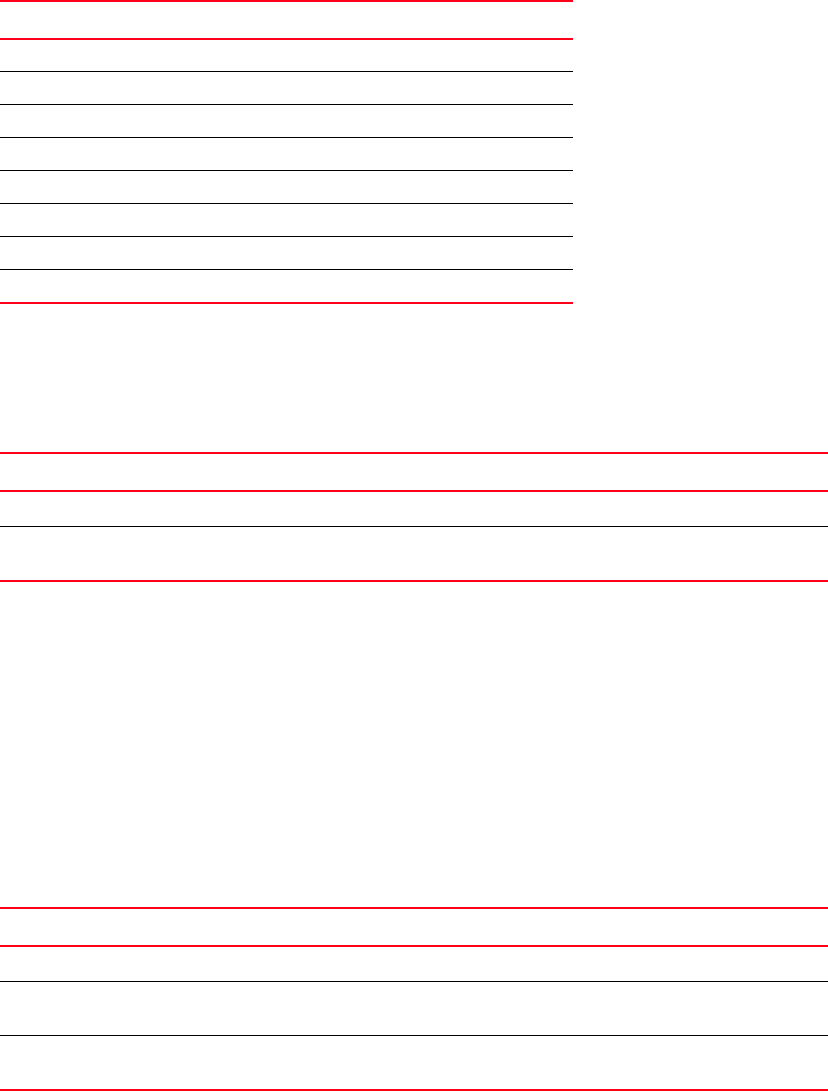Brocade Converged Enhanced Ethernet Administrator's Guide v6.1.2_cee (53-1001258-01, June 2009)
Table Of Contents
- Contents
- Figures
- Tables
- About This Document
- Introducing FCoE
- Using the CEE CLI
- In this chapter
- CEE CLI configuration guidelines and restrictions
- Using the CEE command line interface (CLI)
- CEE CLI RBAC permissions
- Accessing the CEE CLI through the console interface or through a Telnet session
- Accessing the CEE CLI from the Fabric OS shell
- Accessing CEE CLI command modes
- Using CEE CLI keyboard shortcuts
- Displaying CEE CLI commands and command syntax
- Using CEE CLI command completion
- CEE CLI command syntax conventions
- Using CEE CLI command output modifiers
- Configuring VLANs Using the CEE CLI
- In this chapter
- VLAN overview
- Ingress VLAN filtering
- VLAN configuration guidelines and restrictions
- Default VLAN configuration
- VLAN configuration procedures
- Enabling and disabling a CEE interface
- Configuring the MTU on a CEE interface
- Creating a VLAN interface
- Configuring a VLAN interface to forward FCoE traffic
- Configuring a CEE interface as a Layer 2 switch port
- Configuring a CEE interface as an access interface or a trunk interface
- Configuring VLAN classifier rules
- Configuring VLAN classifier groups
- Associating a VLAN classifier group to a CEE interface
- Clearing VLAN counter statistics
- Displaying VLAN information
- Configuring the MAC address table
- Configuring STP, RSTP, and MSTP using the CEE CLI
- In this chapter
- STP overview
- RSTP overview
- MSTP overview
- STP, RSTP, and MSTP configuration guidelines and restrictions
- Default STP, RSTP, and MSTP configuration
- STP, RSTP, and MSTP configuration procedures
- STP, RSTP, and MSTP-specific configuration procedures
- STP and RSTP-specific configuration procedures
- RSTP and MSTP-specific configuration procedures
- MSTP-specific configuration procedures
- 10-Gigabit Ethernet CEE interface-specific configuration
- Global STP, RSTP, and MSTP-related configuration procedures
- Clearing STP, RSTP, and MSTP-related information
- Displaying STP, RSTP, and MSTP-related information
- Configuring Link Aggregation using the CEE CLI
- Configuring LLDP using the CEE CLI
- Configuring ACLs using the CEE CLI
- In this chapter
- ACL overview
- Default ACL configuration
- ACL configuration guidelines and restrictions
- ACL configuration procedures
- Creating a standard MAC ACL and adding rules
- Creating an extended MAC ACL and adding rules
- Modifying a MAC ACL
- Removing a MAC ACL
- Reordering the sequence numbers in a MAC ACL
- Applying a MAC ACL to a CEE interface
- Applying a MAC ACL to a VLAN interface
- Clearing MAC ACL counters
- Displaying MAC ACL information
- Configuring QoS using the CEE CLI
- Configuring FCoE using the Fabric OS CLI
- Administering the switch
- Configuring RMON using the CEE CLI
- Index

Converged Enhanced Ethernet Administrator’s Guide 109
53-1001258-01
Queueing
8
Table 19 presents the Layer 2 default traffic class mapping supported for a COS-based user priority
to conform to 802.1Q default mapping.
Once the traffic class mapping has been resolved for ingress traffic, it is applied consistently
across all queueing incurred on the ingress and egress ports.
Mapping CoS to traffic class
Example of creating CoS-to-Traffic Class QoS Map to map CoS 0 (best effort) to Traffic Class 1 and CoS 1 to below best effort
Traffic Class 0, all other CoS go through unchanged. This mapping matches the default behavior recommended in IEEE 802.1Q
for systems supporting 8 Traffic Classes.
switch:admin>cmsh
switch>enable
switch#configure terminal
Enter configuration commands, one per line. End with CNTL/Z.
switch(config)#qos map cos-traffic-class test 1 0 2 3 4 5 6 7
switch(config)#exit
switch#
Activating a mapping CoS to traffic class
TABLE 19 Default user priority to traffic class mapping
User Priority Traffic class
00
10
21
31
42
52
63
73
Step Task Command
1 Enter global configuration mode.
switch#configure terminal
2 Create the CoS-Traffic-Class mapping
specifying a name and the mapping.
switch(config)#qos map
cos-traffic-class test 1 0 2 3 4 5 6 7
Step Task Command
1 Enter global configuration mode.
switch#configure terminal
2 Specify the 10-gigabit Ethernet interface. In
this example, 0/2 is used.
switch(config)#interface
tengigabitethernet 0/2
3 Activate the CoS to Traffic Class mapping by
name.
switch(conf-if-te-0/2)#qos
cos-traffic-class test










